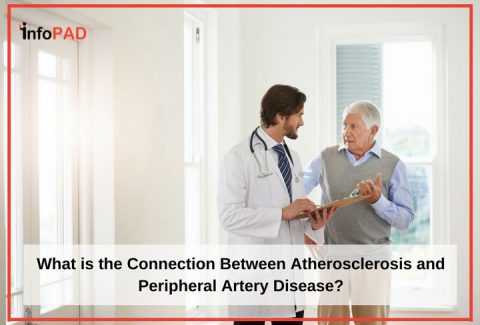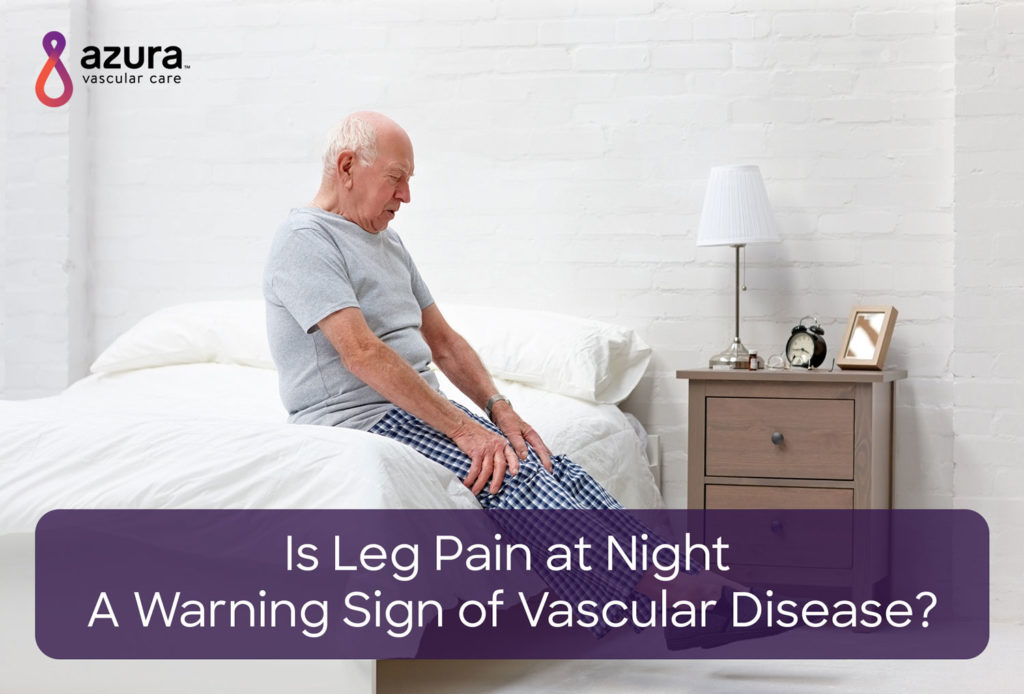
Is leg pain at night often interrupting your sleep? It could more than a normal sign of getting older. Pain in your legs and feet at night, or when trying to sleep, is often a symptom of peripheral artery disease (PAD).
Peripheral artery disease leg pain can occur anywhere in your leg, but the most common places to feel pain are in the muscles of your calf, thigh or buttocks. The pain can range from mild to so severe you can barely walk a very short distance. PAD is a progressive disease. For some people, pain only occurs during the daytime. Others have pain when resting or at night.
Peripheral Artery Disease and Leg Pain at Night
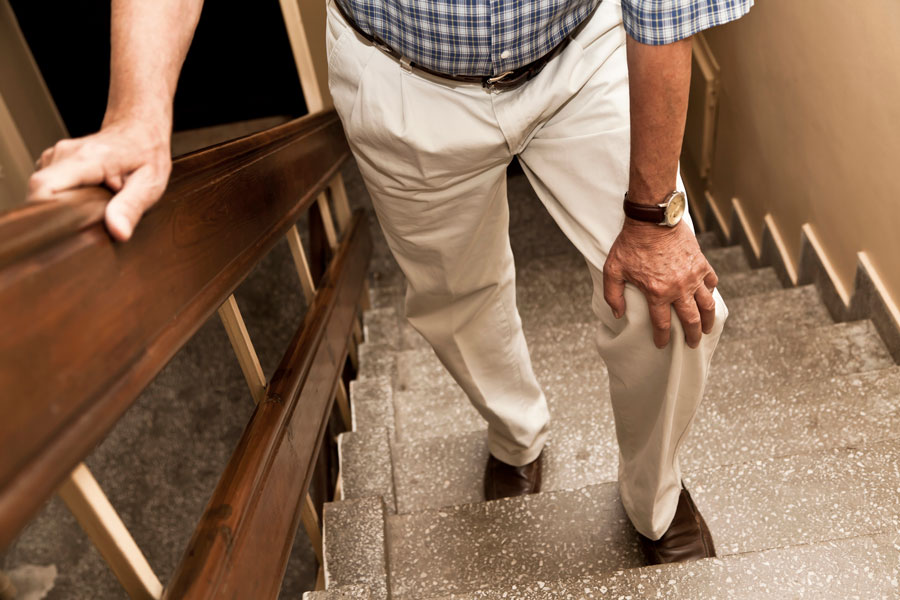
The leg pain or muscle cramping caused by PAD is known as claudication. Symptoms of claudication can be triggered by activity, especially walking or climbing stairs. However, once you stop and rest for a few minutes, it’s not uncommon for the pain to subside.
Nighttime leg pain could be a sign of the worst form of PAD – critical limb ischemia (CLI). With CLI, the pain attacks in your legs or feet can persist for minutes to hours. Leg pain at night can be a sign of a serious condition, and only a healthcare professional can diagnose you with PAD.
What is Peripheral Artery Disease?
Peripheral Artery Disease is a circulatory disease in which blocked arteries reduce blood flow to the extremities, most commonly, the legs and feet. PAD is a relatively common condition – in fact, an estimated 8.5 million people, and nearly 15% of people over the age of 70, in the United States have been diagnosed with it. i,iii
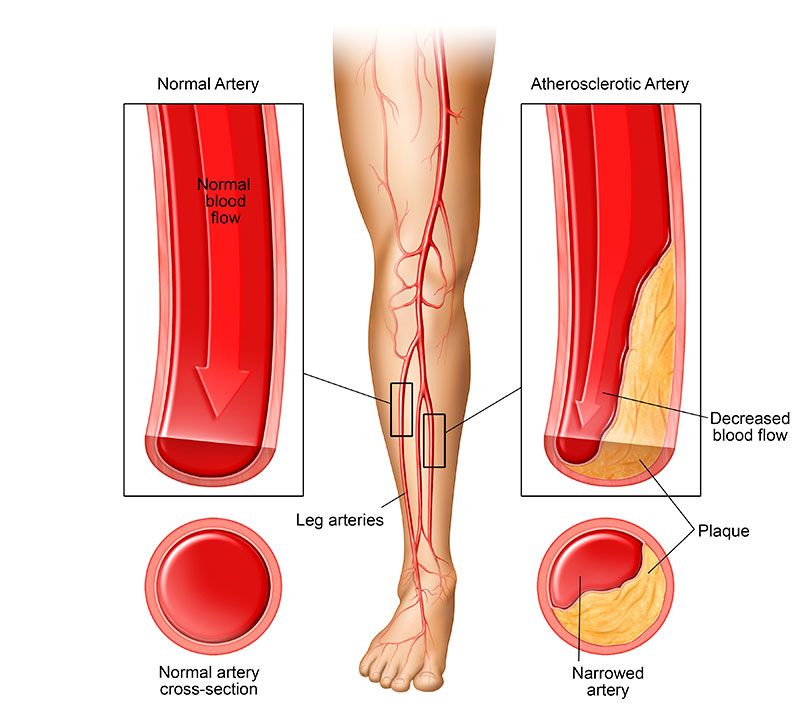
What Causes Peripheral Artery Disease?
PAD is caused by atherosclerosis, or of the arteries. Hardening of the arteries is a condition that causes both coronary artery disease, which can lead to heart attacks, and PAD, which, if severe enough, can lead to amputation of a limb, or even death.2 And like coronary artery disease, PAD is a serious condition.
So…What is Atherosclerosis?
Atherosclerosis is a condition that’s common in older people in which fatty deposits accumulate inside the arteries, creating blockages. Theses blockages are made up of fats and cholesterol, and is referred to as plaque. As plaque builds up in the artery, the walls of the blood vessels begin to thicken, impeding blood flow.ii
It’s uncertain exactly what causes atherosclerosis, but many scientists and doctors believe that damaged arteries cause the plaque to form. Damage to arteries can be caused by:
- High cholesterol
- High blood pressure
- Smoking iv
Other Signs of PAD
Know the warning signs. Leg pain is not the only symptom, there are a number of other signs that could indicate that you have PAD, including:
- Cramping or aching after walking or climbing stairs that subsides with rest
- Numbness or weakness in your legs
- A cold feeling in your lower leg or foot
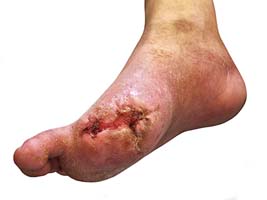
- Sores that won’t heal on your legs, feet or toes
- A weak pulse in your ankles or legs
- Shiny skin and/or a bluish tint to your legs
- Loss of hair on your legs
- Slow growing toenails v
Just like with other cardiovascular conditions, there are things you can do to help manage PAD, such as:
- If you smoke, quit
- Exercise if your doctor says it’s okay
- Lower your cholesterol level
- Eat a healthy diet, including foods low in saturated fat
- Avoid over the counter cold medications that include pseudoephedrine (Advil® Cold & Sinus, Aleve-D® Sinus & Headache, Claritin-D®, Sudafed®, Tylenol® Cold, Zyrtec-D®, others) because they constrict your blood vessels and may increase your PAD symptoms. v
If you think you may have peripheral artery disease, don’t put off seeing your doctor to discuss testing and PAD treatment options if needed. The sooner you get diagnosed, the sooner you and your PAD specialist can determine if you are a candidate for minimally invasive treatments to slow down or stop progression of the disease. Things can get serious if PAD is left untreated, including amputation, stroke or death. Finding PAD early can lower your risk of heart attack or stroke and save your limbs.
Sources:
i Selvin, E., Erlinger, T.P., Prevalence of and Risk Factors for Peripheral Arterial Disease in the United States Results from the National health and nutrition Examination Survey, 1999-2000. Circulation, 2004, 110: p. 738-743.http://circ.ahajournals.org/content/110/6/738.full (accessed 8/18/2016)
ii American Heart Association (2017). Retrieved from www.heart.org.
iii Allison, M.A., Ho, E., Denenberg, J.O., Langer, R.D., Newman, A.B., Fabsitz, R.R., Criqui, M.H., Ethnic-specific prevalence of peripheral arterial disease in the United States. Am J Prev Med, 2007, 32(4): pp. 328-33. http://www.ncbi.nlm.nih.gov/pubmed/17383564 (accessed 8/18/2016)
iv The Mayo Clinic (2017). Peripheral artery disease. Retrieved from: http://www.mayoclinic.org/diseases-conditions/peripheral-artery-disease/symptoms-causes/dxc-20167421
v Mayo Foundation for Medical Education and Research (MFMER). (2015) Retrieved from: https://www.drugs.com/mcd/peripheral-artery-disease-pad


